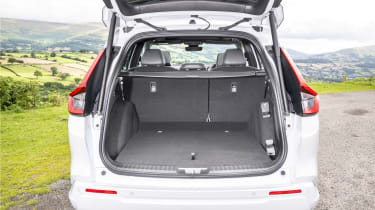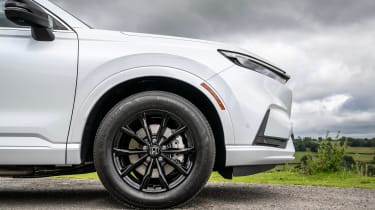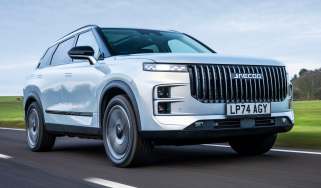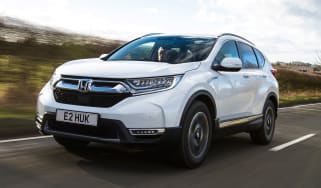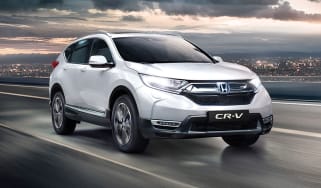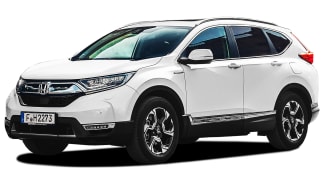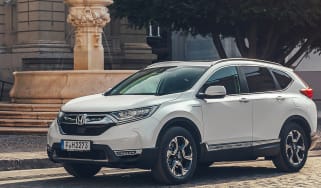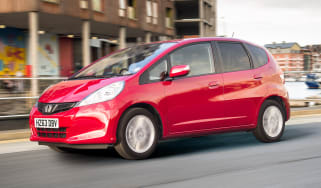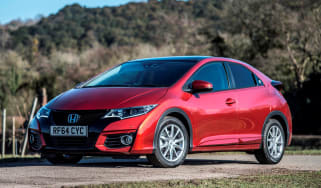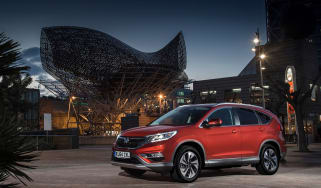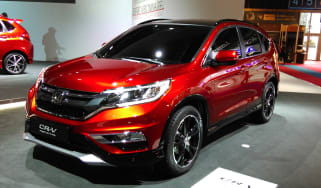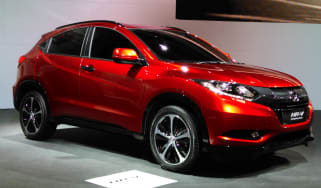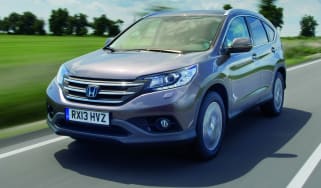Honda CR-V review – once a leading SUV, but now too expensive
“The Honda CR-V is smooth to drive, with low running costs and a practical cabin. But it’s more expensive to buy and insure than most rivals”
Pros
- Improved styling
- Relaxing to drive
- Lots of space
Cons
- More expensive than rivals
- Performance tails off quickly
- Mediocre infotainment
Verdict – is the Honda CR-V a good car?
In isolation, the latest Honda CR-V moves the game on for the brand, with more striking looks inside and out, along with electrified hybrid and plug-in hybrid powertrains offering reduced running costs and just over 50 miles of electric range for the PHEV. It’s also very practical for families, with a spacious cabin and larger boot than most competitors. However, look closer and things fail to stack up – the CR-V has notably less power than a Toyota RAV4, yet costs considerably more.
Honda CR-V models, specs and alternatives
It seems unthinkable now that there are SUVs of all shapes and sizes on the market, but the Honda CR-V was one of a small pioneering group to become popular in the UK, with its Civic-derived underpinnings, car-like driving manners and high-riding stance proving a hit. Since the Honda CR-V first launched there have been various iterations of it and many new rivals it needs to square up to.
The CR-V is now a hybrid-only model, putting fuel economy, low emissions and running costs front and centre. There’s still choice, though, with either self-charging or plug-in hybrid systems on offer. All that fancy tech doesn’t come cheap though, with the CR-V starting from £45,930 at the time of writing, and Honda marketing it as a ‘premium’ SUV, but that sets high expectations from buyers that may still see it as the mainstream model it used to be.
More reviews
There are advantages and disadvantages to choosing between the hybrid or plug-in hybrid Honda CR-V. With the hybrid model there’s no need to charge it between uses when the battery is depleted, while – as it says on the tin – you’ll have to plug in the plug-in to charge it up. The benefit to a plug-in, however, is that you can drive for up to 50 miles on electric power alone, meaning shorter trips around town have the potential to save you money and produce less emissions. However, the PHEV starts from just under £54,000, which certainly isn’t cheap.
The Toyota RAV4 is a long-standing competitor to the Honda CR-V, with a rivalry dating back to the original, and it too now sports hybrid technology and comes in at about £6,000 less than the Honda, while the plug-in hybrid is a staggering £10,000 less. The Nissan Qashqai e-Power hybrid can be had for even less, as well as rivals like the Peugeot 3008. As a result, the Honda CR-V does struggle to make an obvious case for the extra outlay – even if Honda says it’s a premium SUV, it only costs around £4,000 less than a plug-in hybrid BMW X3 which has a much more upmarket reputation.
Still, pricing aside, there’s a lot to like about the new CR-V. We’ve driven both the hybrid and PHEV version, and the latter’s 50-mile electric-only range helps it feel smooth and relaxing around town. Even when its battery does run out, the CR-V feels like a standard hybrid to drive, relying on its electric motor whenever possible and with little noticeable disruption when the petrol engine kicks in. The hybrid version feels very similar to drive, with the same 0-62mph dash of just under 10 seconds and the petrol engine only becoming audible when a burst of prolonged acceleration is required.
Its interior feels more upmarket than before, although this increase in style and quality is tempered somewhat by its price hike, as the CR-V now finds itself competing with more upmarket models like the Audi Q3 and BMW X1. It’s a stronger showing for the Honda in the practicality stakes, however; there’s lots of rear seat space for passengers and an impressive 600-plus litre boot.
|
Trim levels |
Power options |
|
|
Honda CR-V alternatives
As diesel sales dwindle and manufacturers race to provide hybrid and plug-in hybrid models, the market for these electrified models has increased dramatically. For many buyers, it may make more sense to drive a petrol-electric model for the next few years, before making the switch to an all-electric model in time.
Hybrid and plug-in hybrid SUVs:
MPG, running costs & CO2 emissions
Let’s start with the Honda CR-V PHEV, because this is the only version we’ve been able to test so far. New for this generation, it gets a sizeable 18kWh battery pack that means in official WLTP testing it can travel up to 51 miles using electric power alone. It’s a big advantage that also gives the CR-V PHEV its low CO2 emissions figure of 18g/km, reducing its Benefit-in-Kind (BiK) band to 8% for company car choosers.
Like most PHEVs in its class, it doesn’t get fast charging, but a 7kW wallbox can top up the battery in around 2.5 hours. Unfortunately, because every version of CR-V costs over £40,000 (the PHEV in particular is only available in top Advance Tech trim, at nearly £54,000), it also incurs the luxury car VED (road tax) surcharge, elevating its annual cost to more than £500 per year from years two to six of ownership.
Like the smaller Honda HR-V (a hybrid rather than a PHEV), the petrol engine doesn’t often send power straight to the wheels, instead acting as a generator to keep the battery topped up enough for its electric motor to propel the car – helping it feel more like an EV around town. Even if you drive with an empty battery, Honda claims the CR-V plug-in can still return 45.6mpg by acting like a conventional hybrid.
Speaking of which, Honda will also offer a ‘self-charging’ hybrid version of the CR-V, with a cost saving of £5,000 in Advance trim versus the PHEV in its sole Advance Tech trim level. This gets a much smaller 1kWh battery, so it can only drive for short distances in traffic and around town before the petrol motor kicks in. Higher CO2 emissions mean it won’t have the same pull for company car drivers, but for private buyers, its lower price and combined fuel-economy of up to 42.8mpg could prove appealing, especially if home charging isn’t an option.
|
Model |
Fuel economy |
CO2 emissions |
|
Honda CR-V Hybrid |
42.8mpg |
151g/km |
|
Honda CR-V Plug-in Hybrid |
353mpg |
18g/km |
Insurance
We’re not fully sure if it’s because of the advanced powertrain technology now fitted in every CR-V, but its insurance groups have jumped up for this generation. While the outgoing model slotted into groups 22 to 24 (out of 50), the CR-V Hybrid now sits in group 34 in Elegance trim, while the PHEV Advance finds itself in group 37. This is a bit higher than most rivals – the Toyota RAV4 starts in group 25 – so the Honda could cost more to insure as a result.
Electric motor, drive & performance
We tested the plug-in hybrid (PHEV) first, which has 181bhp and 335Nm of pulling power from the combined forces of its electric motor and 2.0-litre petrol engine. Even after its EV range of 51 miles has depleted, it feels quite like an EV to drive. This is particularly the case around town, where the electric motor drives the wheels and the petrol engine acts as a mobile generator to keep the battery topped up. At higher speeds the petrol engine can drive the wheels directly for greater efficiency.
The standard hybrid also offers a smooth power delivery and its 181bhp provides average performance for the class. It’s just as relaxing to drive as the PHEV, with wind and tyre noises the most prominent thing you’ll hear for the vast majority of the time. The petrol engine only sounds coarse during overtakes and heavy acceleration.
0-62mph and top speed
The Honda CR-V is smooth and easy to drive, making the SUV a relaxing companion. When the petrol engine does spring to life it’s also pretty smooth and quiet, unless you select its Sport driving mode, which plays an augmented engine sound through the speakers as you drive. Ultimately, though, the CR-V is rather down on power next to some of its rivals; the Toyota RAV4 PHEV – arguably its closest competitor – boasts 302bhp.
At speeds higher than the 30mph urban limit, the CR-V begins to feel a bit sluggish. While we don’t expect it to behave like a sports car, this means it’s likely to use more fuel as the petrol engine steps in to compensate.
|
Model |
Power |
0-62mph |
Top speed |
|
Honda CR-V Hybrid |
181bhp |
9.4s |
116mph |
|
Honda CR-V Plug-in Hybrid |
181bhp |
9.4s |
121mph |
Interior & comfort
The latest Honda Civic has been well received by critics and owners alike, so it’s little surprise to see the bigger CR-V SUV follow the same path inside. Its dashboard is almost a carbon copy of the Civic, which is no bad thing. We’re fans of the blend between its digital displays and physical buttons for items like climate control, making it easy to operate important functions on the move without having to prod a screen.
While Honda doesn’t have a reputation for interior design flair, this is the most striking offering in a CR-V so far, and stacks up well against rivals. The honeycomb-effect strip of air vents across the fascia looks classy and there are plenty of chrome accents to lift the ambiance.
Infotainment and navigation
Shared with the Civic, the CR-V features a 10.1-inch touchscreen that works better than the setup in the outgoing model, and looks less like it was fitted as an afterthought. It works well enough, but doesn’t boast the level of customisation or large size of some rivals. For instance, the all-electric BYD Atto 3 has a 15.8-inch tablet that can rotate between portrait and landscape modes.
Key features | ||
|
Elegance
|
Advance (Elegance plus…)
|
Advance Tech (Advance plus...)
|
Practicality & boot space
Practicality has long been a key strength of the CR-V, which has traditionally had a very large boot thanks to its boxy shape and some clever storage and seating solutions. Rear knee room is even better for this generation, with 16mm more than before. Back seat passengers can also recline their seats through no less than eight positions to get comfy on longer trips, and there’s a flat floor and wide centre squab, which makes the middle seat more usable.
|
Size comparison | |||
|
Model |
Length |
Width |
Height |
|
Honda CR-V SUV |
4,706mm |
1,866mm |
1,673mm |
|
Toyota RAV4 SUV |
4,600mm |
1,855mm |
1,685mm |
|
Ford Kuga PHEV SUV |
4,629mm |
1,883mm |
1,680mm |
|
Nissan Qashqai SUV |
4,425mm |
1,835mm |
1,625mm |
Boot space
Despite the CR-V being offered with a HEV (hybrid) or PHEV (plug-in hybrid) powertrain, boot space is still impressive, with up to 617 litres of luggage volume behind the rear seats in the PHEV. This figure includes an underfloor storage area, which is perfect for stowing charging cables. It also outshines the RAV4, which has a boot measuring 587 litres. This number shrinks to 596 litres for the hybrid version owing to its battery being located under the boot instead of the middle of the car.
|
Boot space comparison | |
|
Model |
Boot space |
|
Honda CR-V SUV |
587l |
| Honda CR-V Plug-in Hybrid | 617l |
|
Toyota RAV4 SUV |
520-580l |
|
Ford Kuga PHEV SUV |
412l |
|
Nissan Qashqai SUV |
455-504l |
Reliability & safety
Honda has a good reputation for reliability, and while the CR-V is packed with electrified technology, the manufacturer has also been selling hybrids for many years. However, the Japanese maker could only muster 18th out of 32 brands in our most recent 2023 Driver Power survey. The results did include more reassuring reliability statistics, with just 15% of Honda owners reporting an issue with their car in the first year, which is lower than average.
Safety
Unfortunately the standard Honda CR-V failed to achieve the full five-star rating when it was tested by Euro NCAP in 2024 in standard guise, which is disappointing for a car of this price range. It was rated well for adult occupant and child occupant protection, meaning that it achieved a four-star score, but the lack of safety equipment fitted as standard meant it achieved 67% in the Safety Assist category and 76% for protection of vulnerable road users.
It’s worth noting that when fitted with the Safety Pack, the CR-V achieves the full five-star rating, thanks to a score of 79% in the Safety Assist category and 80% for the Vulnerable Road User category – it’s worth specifying this if safety is of a priority and you think you’ll see the benefits of the extra features.
The Honda CR-V was the brand’s first European model to come with its latest ‘Sensing 360’ suite of active safety features designed to “remove blind spots around the vehicle”. In reality, we found this to be somewhat mixed out on the road. While the road sign indicator worked well, and the 360-degree radar is handy around town, the lane keep assist was far too nagging. We also have concerns that the image from the side camera which takes over the central screen while indicating could encourage drivers to not indicate if they need to see the sat nav screen. This can be turned off in a sub-menu, but we’d prefer a less intrusive implementation.
Which Is Best?
Cheapest
- Name2.0 eHEV Elegance Sensing 5dr eCVT
- Gearbox typeAuto
- RRP£45,235
Most Economical
- Name2.0 ePHEV Advance Tech 5dr eCVT
- Gearbox typeAuto
- RRP£50,410
Fastest
- Name2.0 eHEV Elegance Sensing 5dr eCVT
- Gearbox typeAuto
- RRP£45,235





